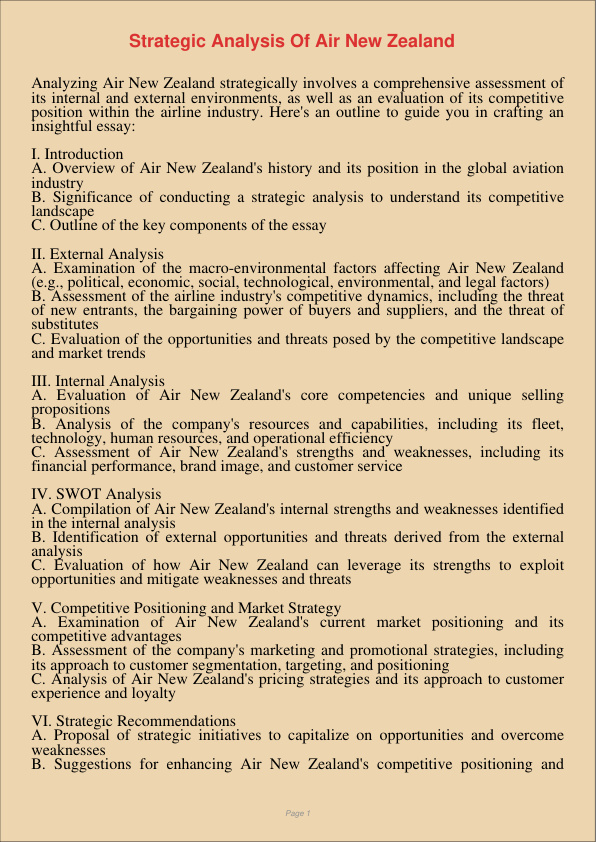Strategic Analysis Of Air New Zealand
Jan 7, 2024
air new zealand
strategic analysis
Human Resources
Visual Arts & Film Studies

Analyzing Air New Zealand strategically involves a comprehensive assessment of its internal and external environments, as well as an evaluation of its competitive position within the airline industry. Here’s an outline to guide you in crafting an insightful essay:
I. Introduction A. Overview of Air New Zealand’s history and its position in the global aviation industry B. Significance of conducting a strategic analysis to understand its competitive landscape C. Outline of the key components of the essay
II. External Analysis A. Examination of the macro-environmental factors affecting Air New Zealand (e.g., political, economic, social, technological, environmental, and legal factors) B. Assessment of the airline industry’s competitive dynamics, including the threat of new entrants, the bargaining power of buyers and suppliers, and the threat of substitutes C. Evaluation of the opportunities and threats posed by the competitive landscape and market trends
III. Internal Analysis A. Evaluation of Air New Zealand’s core competencies and unique selling propositions B. Analysis of the company’s resources and capabilities, including its fleet, technology, human resources, and operational efficiency C. Assessment of Air New Zealand’s strengths and weaknesses, including its financial performance, brand image, and customer service
IV. SWOT Analysis A. Compilation of Air New Zealand’s internal strengths and weaknesses identified in the internal analysis B. Identification of external opportunities and threats derived from the external analysis C. Evaluation of how Air New Zealand can leverage its strengths to exploit opportunities and mitigate weaknesses and threats
V. Competitive Positioning and Market Strategy A. Examination of Air New Zealand’s current market positioning and its competitive advantages B. Assessment of the company’s marketing and promotional strategies, including its approach to customer segmentation, targeting, and positioning C. Analysis of Air New Zealand’s pricing strategies and its approach to customer experience and loyalty
VI. Strategic Recommendations A. Proposal of strategic initiatives to capitalize on opportunities and overcome weaknesses B. Suggestions for enhancing Air New Zealand’s competitive positioning and differentiation C. Recommendations for diversification, expansion, or strategic partnerships to drive sustainable growth
VII. Innovation and Sustainability A. Evaluation of Air New Zealand’s approach to innovation and technological advancements in the aviation industry B. Analysis of the company’s efforts towards sustainability, including environmental initiatives and corporate social responsibility C. Recommendations for further integrating innovation and sustainability into Air New Zealand’s business strategy
VIII. Conclusion A. Recap of the main findings from the strategic analysis of Air New Zealand B. Emphasis on the importance of leveraging strengths and addressing weaknesses for long-term success C. Call to action for implementing the suggested strategic recommendations to maintain a competitive edge in the global aviation market
Make sure to support your analysis with data, industry reports, and relevant case studies to provide a comprehensive and well-informed assessment of Air New Zealand’s strategic position within the aviation industry.